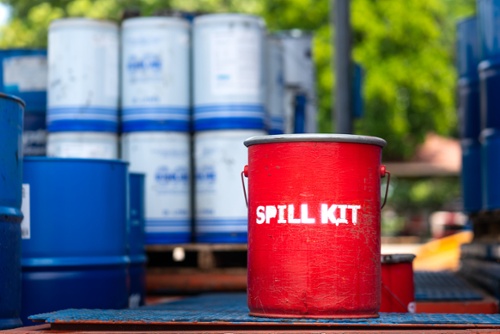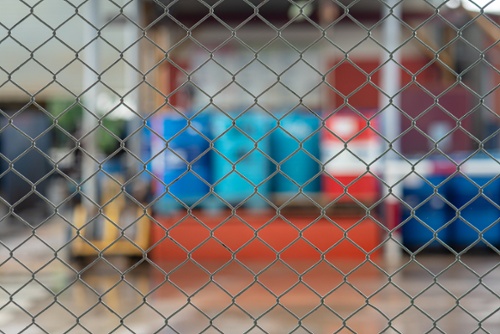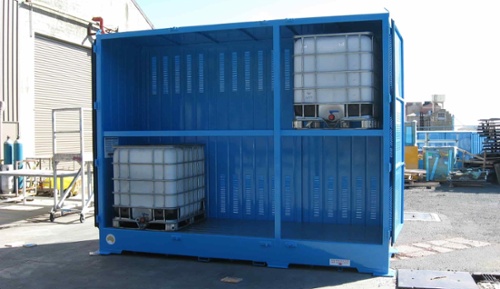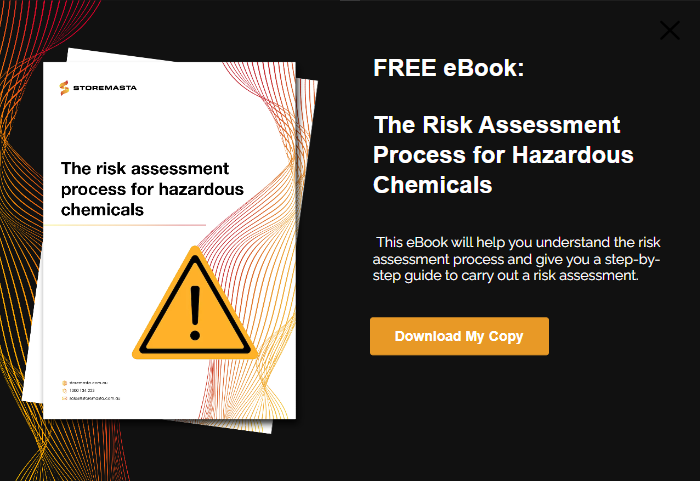When you’re storing hazardous chemicals in the outdoor environment, there are a range of risks that are unique to outdoor storage. One of these issues is the added risk of theft, vandalism and general misuse of onsite chemicals. When housed indoors, in a chemical storage cabinet or compliant indoor store, chemicals are less likely to be tampered with due to the additional security measures of the premises. Things like secure staff entry, CCTV and lockable work areas means that theft is less likely to occur in the indoor environment. Therefore, when considering your outdoor chemical store, it’s important to think about the ways in which you can minimise unauthorised entry to your store.
In this post, we’ll be detailing how engineering controls, as well as administrative controls, can assist in securing your inventory of hazardous substances.
IMPORTANT: We suggest referring to the Australian Standards, in conjunction with your own risk assessment, to determine the most suitable methods of securing your outdoor chemical stores. You may wish to add further layers of security to your site, to assist with the prevention of theft, vandalism and misuse.
Chemical Safety and Store Security
Whether you’re storing flammable liquids (fire, explosion), toxic substances (human harm, environmental damage) or corrosive chemicals (property destruction), there are a multitude of issues that may arise if chemicals aren’t kept in a secure and controlled manner.
Hazardous substances and dangerous goods pose both health and physical hazards, which can result in work health and safety issues, property and vehicle loss, environmental contamination, harm to wildlife and marine life, and more.

Harm to human health, property and the environment can occur if security isn’t effective in your outdoor chemical storage areas.
Some examples of hazards include:
- Health hazards – properties of a chemical that result in adverse health effects, such as headaches, dermatitis, nerve damage, cancer or infertility issues.
- Physical hazard – properties of a chemical that can result in harm to people or property, such as explosions, corrosion, fire and chemical reactions.
If chemicals are accessed by unauthorised personnel, they can cause harm in many ways. Some of these ways may be intentional (vandalism) and some may be unintentional (misuse, theft).
REMEMBER: Under WHS Regulations, you have a responsibility to control the risks associated with hazardous chemicals. This includes creating a safe working environment where only trained staff are allowed to have access to these dangerous substances.
Dangerous goods can cause incidents through:
- Vapours – many dangerous goods emit harmful vapours if they are exposed to air. Vapours can cause health problems such as asthma, as well as asphyxiation, poisoning and even fatalities.
- Chemical reactions – an unauthorised person is not going to understand the guidelines that relate to incompatible substances and those that react dangerously. Therefore, an incident could easily occur where incompatible substances mix, causing harmful gases, explosions or a dangerous chemical reaction.
- Spillage – chemical spills can affect people, property and the environment depending on the properties of the substance.
Like to know more about spill solutions?
Protecting Hazardous Chemical Stores From Theft
There are a range of controls, including engineering and administrative controls, that can work in unison to reduce the risk of theft at your website. By reducing the likelihood of unauthorised entry, you’re assisting your organisation in a variety of ways, including:
- Protection of inventory – securing your inventory means that it’s less likely that chemicals will be used too often, in an incorrect manner or wasted.
- Cost-effectiveness – in addition to the safety concerns of theft, securing your store enables you to reduce the costs associated with chemicals going missing.
- Control of potential hazards – if hazardous substances fall into the wrong hands, it can lead to immediate and very serious hazards that may affect your site, the surrounding environment and even the community.
What Requirements Relate To Store Security?
While we suggest that all outdoor chemical storage facilities be equipped with the appropriate security measures, there are several classes of dangerous goods, such as corrosive chemicals, toxic substances and organic peroxides, that have specific requirements that relate to store security.

All outdoor chemical storage facilities should be equipped with adequate security against unauthorised entry.
For example, AS NZS 4452:1997 – The storage and handling of toxic substances, we see requirements that relate to security of toxic stores.
Section 1.8 states:
SECURITY OF STORAGE AREAS: All storage areas shall be appropriately secured from access by unauthorised persons. The storage area shall be considered a ‘restricted area’.
When detailing the construction and type of package stores permitted, the Standard explains that toxic chemicals may be stored in a:
- Roofed structure or room attached to an external wall of another building.
- Freestanding, roofed structure or building (not attached to any other building).
- Outdoor storage with fencing.
Therefore, when you’re storing hazardous substances, check the relevant Australian Standard for the precise requirements that relate to the security of your store.
REMEMBER: If you’re storing particularly volatile chemicals, there may be further requirements that relate to their security. If you’re storing Class 4 Desensitized explosives, any evidence of attempted forced entry to, or theft of stock or an unaccountable stock discrepancy, must be immediately reported to the police or appropriate authority in accordance with regulation.
What Are The Options For Store Security?
While we have highlighted a variety of options for outdoor chemical storage, many businesses opt for chemical storage containers as they’re a more reliable and cost-effective option when compared with custom chemical stores.
Choosing a container that’s been built to meet the Australian Standards means that your business is installing a ready-made engineering control that will actively minimise the various risks posed by your stored chemicals – including unathorised entry.
However, you can also concentrate on inner- and outer-perimeter security measures to bolster the protection provided by your containers.
Measures may include:
- Visitor logs and security escorts
- Security fencing
- CCTV
- Security alarms
- Locked entrances and exists in specific areas
- Restricted entry to site through staff identification methods
While there are many options for outdoor chemical storage, compliant storage containers are generally more cost-effective than custom-made stores which are built on site.
What Are ISO Locking Bars?
If you’ve been researching drum, IBC chemical stores or DG containers, you’ve probably come across the feature of ISO locking bars. But what are they – are how do they provide security for your stored chemicals?
ISO locking bars refers to the compliant locking system, that’s recognised by the International Organization for Standardization. In Australia, dangerous goods storage equipment manufacturers should comply with ISO Standards, so their equipment provides safety and compliance. Adhering to these standards allows manufacturers to produce equipment that meets safety standards and provides the highest quality product to the customer.
ISO locking bars are a specific type of locking mechanism that’s fitted on our range of outdoor chemical storage containers. More sophisticated than a lockable handle that you may find on an indoor cabinet, the locking bars for outdoor containers offer maximum protection against unauthorised entry.

ISO locking bars are constructed to meet the highest standards of security for outdoor chemical stores.
Constructed from steel, the mechanism locks down both container doors in one single motion, and offers protection against any type of attack, including bolt cutters, hammers, crow bars and saws.
IMPORTANT: We manufacture our full range of outdoor chemical storage containers with ISO locking bars — regardless of the dangerous goods class of the container. This is to offer the best protection for businesses who may be susceptible to unauthorised entry of their outdoor chemical storage areas.
Administrative Controls For Added Security
In addition to the engineering controls put in place to secure outdoor stores, there are some further suggestions to increase the security of your hazardous chemical storage areas. Administrative controls are designed to work in support of elimination, substitution and engineering controls, as per the Hierarchy of Controls.
Administrative controls are designed to minimise the remaining risks, after considering the elimination of hazards, the substitution of hazardous chemicals, and the engineering controls to reduce risk.
You may adopt a range of administrative controls to bolster the security of your outdoor chemical storage. These may include:
- Vetting all authorised staff – having strong procedures in place for HR matters will ensure that you’re hiring staff who can manage the responsibilities of working with dangerous goods and hazardous chemicals.
- Restricting access to chemical storage areas – having procedures in place to restrict access to outdoor storage for specific staff or teams, either on specific days or every day.
- Providing further supervision of all handling and storage areas – implementing more stringent supervision during working hours.
- Adopting extra security measures – such as fingerprint or face recognition access to chemical storage areas, logbooks of handling and storage tasks, CCTV in all outdoor chemical handling and storage zones.
- Training for staff – highlighting the importance of security with hazardous chemicals, and detailing procedures for addressing security breach incidents.
- Regular inspections of outdoor stores – while we always recommend weekly inspections of indoor cabinets and outdoor storage containers, the scheduling of regular inspections can assist in the ongoing maintenance and security of your chemical storage areas. Keep detailed reports of your inspections and ensure that another responsible staff member has supervised and approved the inspection.
- Maintenance of broken or damaged locks and doors – maintaining your chemical controls, such as a dangerous goods storage container, is part of you ongoing compliance obligation. Ensure that any damage is immediately noted and actioned by supervising staff, so that all storage areas remain secure and effective.
Securing Your Chemical Stores
Would you like to learn more about reducing risk in your chemical stores? The first step is to conduct a risk assessment on your hazardous chemicals.
To find out more about the risk assessment process, download a copy of our helpful guide. It's full of practical advice and expert tips, so you can help create a safer working environment at your site.
Joining the team as a Dangerous Goods Storage Consultant, Melissa Hampton became Storemasta's Marketing Manager in late 2021. With extensive knowledge and experience in chemical compliance, Melissa is responsible for leading the Marketing team and helping shape their marketing strategy. In her spare time, you can find Melissa hiking, swimming and enjoying the great outdoors in beautiful north-west Tasmania.


